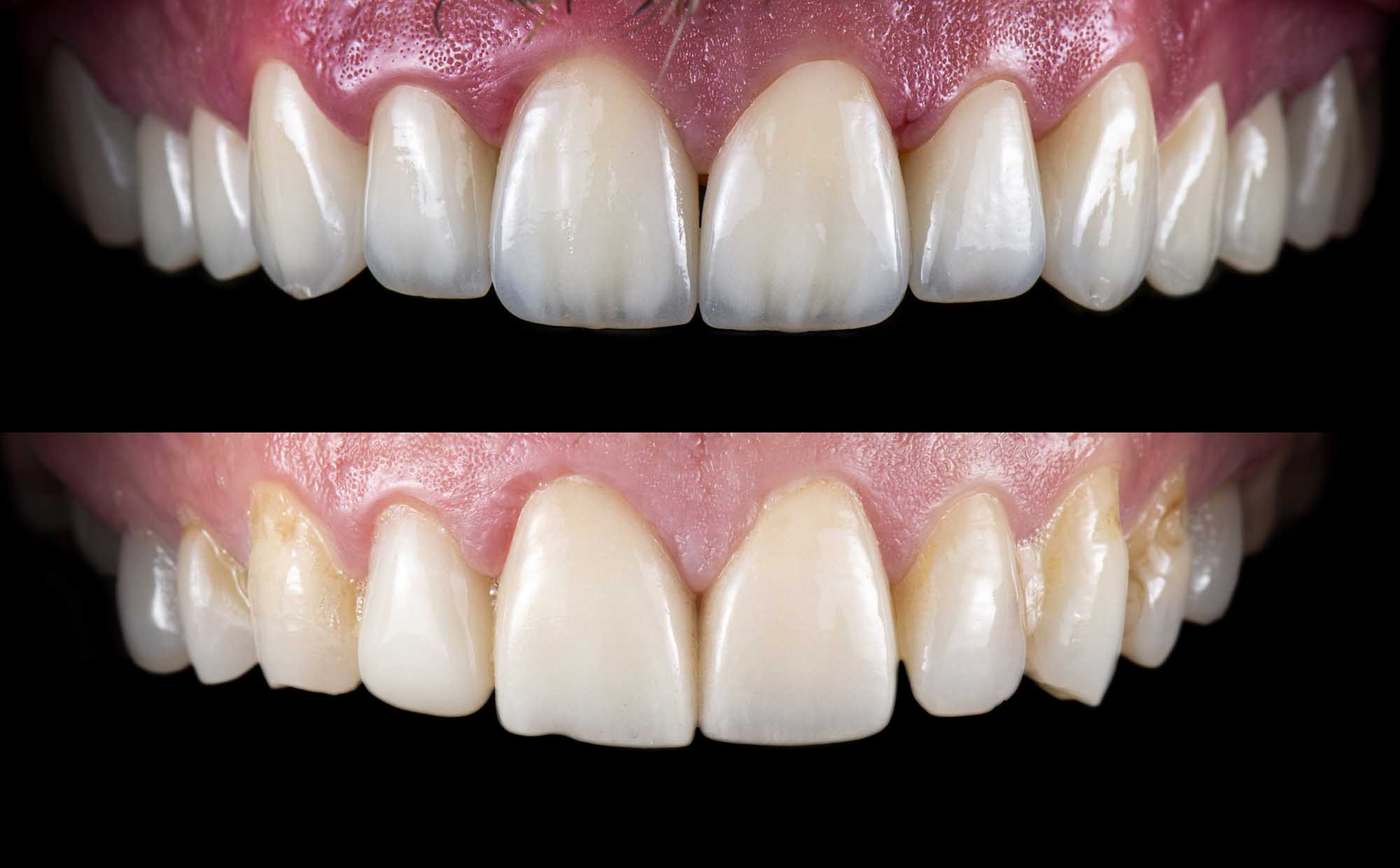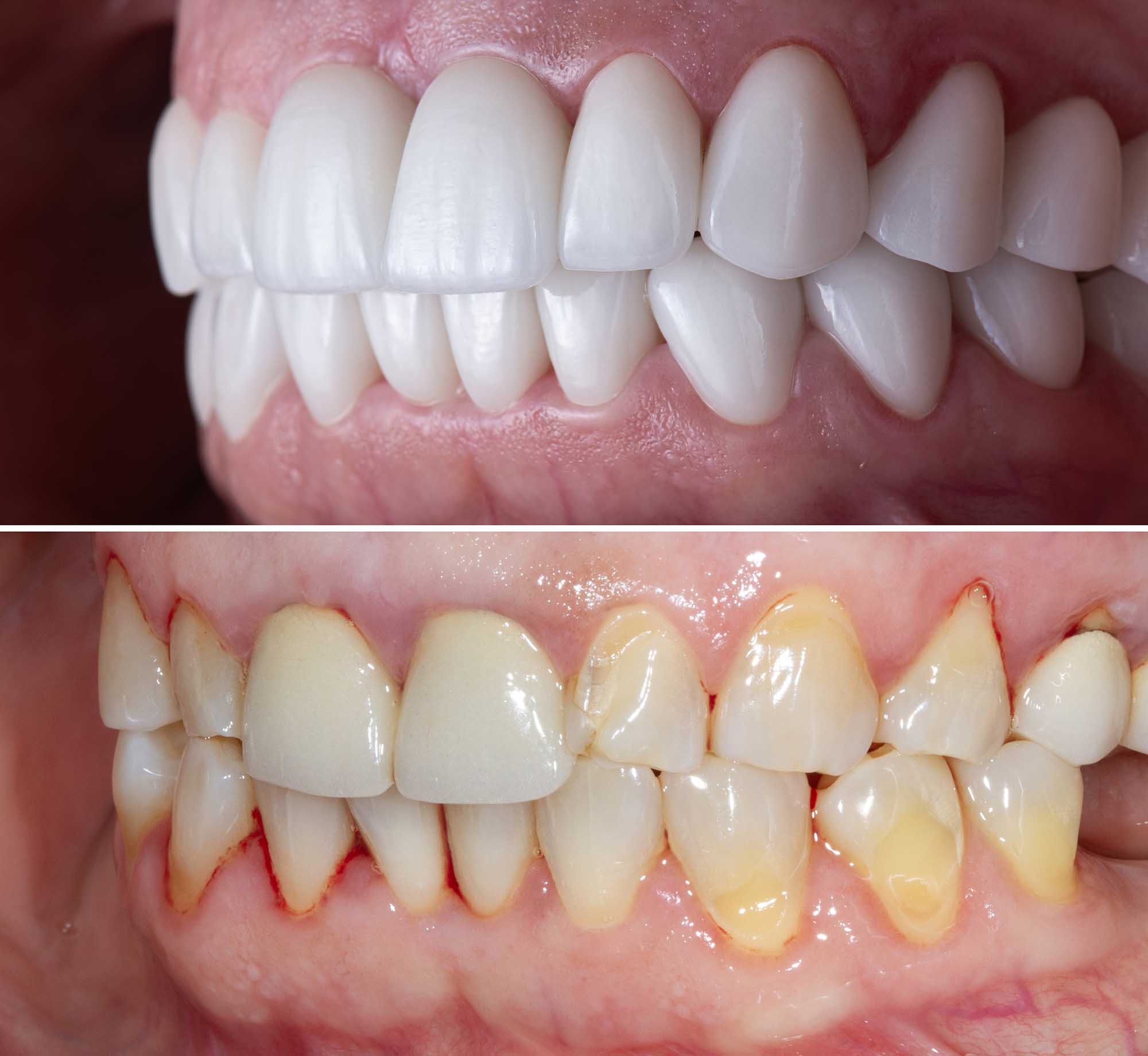Composite veneers have become an increasingly popular choice for individuals seeking to enhance their smile.
They offer a less invasive and more affordable alternative to traditional porcelain veneers, making them accessible to more patients.
What Are Composite Veneers?
Composite veneers are tooth-coloured composite resin layered over your teeth, often used in dental bonding.
Unlike porcelain veneers, which are created in a lab and require multiple dental visits, composite veneers are typically sculpted directly onto the teeth by the dentist during a single appointment. This allows for a quicker and more customizable process.
How Are Composite Veneers Applied?
Step 1: Consultation
During the initial consultation, your dentist will comprehensively examine your dental health. This includes checking for any underlying issues such as cavities, gum disease, or structural problems that might need to be addressed before applying veneers.
Your cosmetic dentist will also take detailed notes on your aesthetic goals. This is the time to discuss any specific concerns about your smile, such as your teeth’ colour, shape, or alignment.
Dentists may take photographs or impressions of your teeth to aid in planning the veneer application.
Step 2: Preparation
Unlike traditional veneers that may require significant alteration of your natural teeth, composite veneers require minimal preparation.
The dentist will thoroughly clean your teeth to ensure no plaque or debris interferes with the bonding process.
After washing, the dentist will lightly etch the surface of your teeth using a mild acid solution. This etching creates a slightly rough texture on your teeth, which helps the composite material adhere more effectively.
In some cases, a bonding agent may also be applied to enhance the adhesion of the composite resin.
Step 3: Application
The application of composite veneers is where the dentist’s artistry truly shines.
Dentists apply composite resin to your teeth in small, manageable layers. This layering technique allows for precise control over the shape and thickness of the veneers.
Each layer is carefully sculpted and moulded to achieve the desired look, addressing imperfections such as gaps, chips, or uneven edges.
Once a layer is shaped correctly, the dentist will use a special curing light to harden the resin. This process is repeated until the dentist is satisfied with the appearance and thickness of the veneers.
The composite material can be tinted to match the exact shade of your natural teeth, ensuring a seamless and natural-looking result.
Step 4: Polishing
After the final layer of composite resin has been applied and cured, the dentist will begin the polishing process.
Polishing is crucial for achieving a smooth, glossy finish that mimics the natural sheen of enamel.
The dentist will use polishing tools and pastes to buff the veneers, removing rough edges or imperfections. This step enhances the veneers’ appearance and helps prevent plaque buildup and staining.
The result is a set of beautifully crafted veneers that blend perfectly with your natural teeth, providing you with a radiant and confident smile.
Following these detailed steps, composite veneers can be applied efficiently and effectively, transforming your smile in just one visit.
Benefits of Composite Veneers

Composite veneers are popular for many patients due to their numerous advantages. Here are some detailed benefits of opting for composite veneers:
Affordability
One of the most significant benefits of composite veneers is their cost-effectiveness. Composite veneers are generally much less expensive than porcelain veneers. This affordability makes them accessible to more patients who want to enhance their smiles without breaking the bank.
The lower cost is due to the more straightforward manufacturing process and the ability to apply them directly to the teeth without needing custom laboratory work, reducing material and labour costs.
Quick Results
Composite veneers offer the advantage of quick results, often being completed in just a single dental visit.
Traditional porcelain veneers require multiple appointments, including an initial consultation, tooth preparation, and a final fitting after being manufactured in a dental lab.
In contrast, the dentist applies composite veneers directly to the teeth, sculpting and hardening them layer by layer. This direct application method means you can walk out of the dental office with a transformed smile after just one appointment, making it a convenient option for busy schedules or those seeking immediate results for an upcoming event.
Reversibility
The process of applying composite veneers is minimally invasive, which means that, in many cases, the natural teeth remain largely unaltered.
Unlike porcelain veneers, which often require significant reshaping of the tooth enamel, composite veneers involve minimal tooth preparation.
The composite material is bonded directly onto the tooth surface without extensive drilling or enamel removal. This preserves the natural structure of your teeth, allowing for the possibility of reversibility.
If you no longer want the veneers or wish to explore other cosmetic options, the composite material can be removed with minimal impact on your natural teeth.
Customizability
Composite veneers offer a high degree of customizability, allowing the dentist to create a smile that perfectly matches your aesthetic preferences.
During the application process, the dentist can sculpt and shape the composite resin directly on your teeth, making real-time adjustments to achieve the desired look. A hands-on approach allows precise control over the outcome, addressing concerns like tooth shape, size, and alignment.
Additionally, the colour of the composite material can be tailored to blend seamlessly with your natural teeth, ensuring a harmonious and natural-looking result. This level of customization means that each veneer is uniquely crafted to suit your smile, providing a personalized and satisfying cosmetic enhancement.
These benefits make composite veneers attractive for many individuals seeking to improve their dental aesthetics.
If you’re considering composite veneers, discussing these advantages with your dentist can help you decide whether they are the right choice.
Potential Drawbacks
While composite veneers offer numerous benefits, it’s essential to consider some potential drawbacks before deciding if they are the right choice for you.
Here are some detailed considerations to keep in mind:
Durability
Although practical, composite veneers are generally less durable than their porcelain counterparts.
The composite resin material in these veneers is not as strong or long-lasting as porcelain, making them more susceptible to wear and tear.
Over time, composite veneers can be more prone to chipping, cracking, or breaking, especially if exposed to excessive force from biting hard foods or habits like teeth grinding.
Additionally, composite veneers can stain more easily than porcelain.
Factors such as smoking, drinking coffee, tea, red wine, or consuming other staining substances can cause the composite material to discolour over time, potentially requiring more frequent replacements or repairs.
Maintenance
One critical consideration with composite veneers is the need for more frequent maintenance than porcelain veneers.
Due to their propensity to chip or stain, composite veneers may require regular touch-ups to maintain their appearance and functionality. This can involve periodic polishing to remove surface stains, minor repairs to address chips or cracks, and possibly even total replacements if the veneers become significantly damaged.
This ongoing maintenance can add to the long-term cost and effort required to keep your smile looking its best.
Regular dental check-ups are essential to monitor the condition of the veneers and address any issues promptly.
Aesthetic Limitations
While composite veneers can significantly improve the appearance of your teeth, they may not achieve the same level of aesthetic perfection as porcelain veneers.
Porcelain’s unique transparency and lustre closely mimic the natural enamel of teeth, giving it a lifelike and highly esthetic appearance.
Composite resin, on the other hand, can sometimes lack this depth and clarity, making it slightly less natural-looking.
This difference in appearance may be more noticeable in certain lighting conditions or when viewed up close.
Additionally, achieving a perfect colour match with composite material can be more challenging, particularly for patients seeking a highly customized and nuanced shade for their veneers.
Understanding these potential drawbacks is crucial when considering composite veneers.
While they offer a convenient and cost-effective solution for enhancing your smile, weighing these considerations against the benefits is essential.
Discussing these aspects with your dentist can help you make a well-informed decision and determine if composite veneers are the best option for your dental and aesthetic needs.
Who Is a Good Candidate for Composite Veneers?
Composite veneers are suitable for individuals looking to correct minor cosmetic imperfections such as:
- Discoloured teeth
- Slightly crooked or misaligned teeth
- Gaps between teeth
- Chipped or worn teeth
However, they may not be the best option for those with significant dental issues or severe misalignment.
Caring for Your Composite Veneers
Proper care is essential to ensure the longevity and appearance of your composite veneers.
On average, composite veneers last between 5 to 7 years. However, their lifespan can vary depending on several factors, including:
- Oral Hygiene: Proper oral hygiene, including regular brushing and flossing, can significantly extend the life of composite veneers.
- Diet: Avoiding hard foods, staining beverages, and habits like biting nails or chewing on pens can help prevent damage and staining.
- Maintenance: Regular dental checkups and professional cleanings are essential for monitoring the condition of the veneers and addressing any issues early.
- Lifestyle Factors: Habits such as smoking or frequent consumption of staining substances like coffee, tea, or red wine can affect the appearance and longevity of the veneers.
- Teeth Grinding: Individuals who grind or clench their teeth may experience more wear and tear on their composite veneers, potentially reducing their lifespan. Using a nightguard can help mitigate this issue.
With proper care and maintenance, some patients may find that their composite veneers can last longer than the average range.
Discussing care strategies with your dentist can help maximize the longevity of your composite veneers, whether you are considering them or currently have them.
By following these detailed care tips, you can maintain your veneers and enjoy a beautiful smile for years to come:
Practice Good Oral Hygiene
Maintaining excellent oral hygiene is crucial for preserving the appearance and integrity of your composite veneers.
Brush your teeth at least twice daily using a soft-bristled toothbrush and non-abrasive toothpaste to prevent plaque buildup and staining.
Brush gently but thoroughly around the edges of the veneers to remove food particles and bacteria.
Floss daily to clean between your teeth and around the veneers, as this helps prevent gum disease and decay in the areas where the veneers are bonded.
Consider using an antimicrobial mouthwash to reduce bacteria further and keep your breath fresh.
Avoid Hard Foods
Being mindful of your diet is essential to prevent damage to your composite veneers. Hard foods can exert excessive pressure on the veneers, leading to chips or cracks.
Avoid biting into hard items such as ice, candy, nuts, and raw vegetables. Instead, cut these foods into smaller pieces and chew them with your back teeth to minimize the risk of damaging the veneers.
Also, avoid habits that can harm your veneers, such as chewing on pens, fingernails, or other complex objects.
If you grind or clench your teeth, especially at night, talk to your dentist about getting a custom mouthguard to protect your veneers and natural teeth.
Regular Dental Checkups
Regular dental visits are essential for monitoring the health of your composite veneers and natural teeth. Schedule checkups and professional cleans with your dentist at least twice a year.
During these appointments, your dentist will examine the condition of your veneers, ensuring they are intact and free from damage or staining.
Professional cleanings will help remove plaque and tartar buildup that you might miss with regular brushing and flossing.
Your dentist can also polish the veneers to maintain their shine and recommend any additional care or touch-ups that might be needed.
If you notice any issues with your veneers, such as rough edges or discolouration, schedule an appointment promptly to address them before they become more serious.
By following these detailed care tips, you can ensure that your composite veneers remain in excellent condition, providing you with a radiant and confident smile.
Proper oral hygiene, dietary precautions, and regular dental checkups are vital to maintaining the longevity and appearance of your veneers.
 Conclusion
Conclusion
Composite veneers are an excellent option for those looking to enhance their smile quickly and affordably. They offer a customizable and less invasive solution compared to traditional porcelain veneers.
If you’re considering composite veneers and want to learn more about how they can transform your smile, the experienced team at Smile Time Family Dental in Boondall is here to help.
Contact a North Brisbane, Boondall Cosmetic Dentist Near Me to schedule a consultation and take the first step toward achieving the smile you’ve always wanted.
Your dream smile is just an appointment away!



